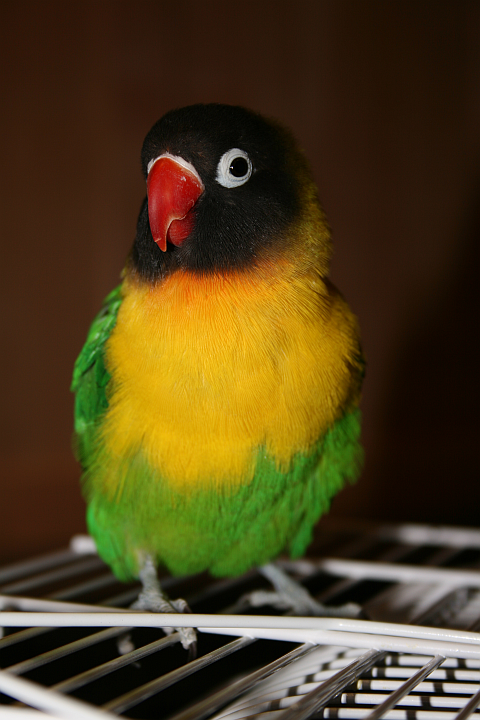 Click here to read the first part of this article.
Click here to read the first part of this article.
Social Groups and Compatible Species
Wild lovebirds live colonially, and can be kept in groups if your cage or aviary is large enough. Of course managing a group can be difficult, as squabbles will arise, and, perhaps due to some form of stress, certain individuals will pluck the young of others. It is best to separate breeding lovebirds from the group.
These plucky birds can hold their own even when housed with much larger parrots, but care must always be taken in these circumstances. But if you are set on mixing small and large parrots, Masked Lovebirds are a good choice.
Handling and Enrichment
Natural clowns, Masked Lovebirds have quite bold, inquisitive personalities, and are relatively fearless (please see The Masked Lovebird – Natural History). They seem naturally pre-disposed to become trusting pets, but only if acquired at a young age. Adults that have not been tamed are nearly impossible to handle.
Masked Lovebirds are capable of imitating words, but rarely do so. Tame ones are so charming that this will not be noticed, and their constant antics will leave you wanting little more from a pet bird. They are highly trainable and will readily use a variety of bird toys.
Breeding
Pet Masked Lovebirds breed readily but the sexes are difficult to distinguish. Paired birds preen each other incessantly, but same-sexed birds often form close bonds and may appear to be a mated pair.
Females are more sturdily built and a bit heavier (but only by a few grams) than males, and perch with their legs spread out a bit. The female’s head is flatter and broader than that of the male (which is dome-shaped), but this varies among individuals and may only be apparent after you have observed a good number of birds. The males’ pelvic bones (just above the vent) are close together, almost touching, while those of females in breeding condition are widely spaced. Males often scratch their heads with their feet prior to mating.
Masked Lovebirds build bark and stick nests and will utilize nest boxes (20” x 10” x 10”) or hollow logs. Females carry the nesting material, transporting it in their beaks (some related species carry bark wedged beneath their feathers). Provide large amounts of willow and other fresh (from live, sap-bearing branches) bark to nesting birds, and continue to do so throughout the incubation and rearing periods. Wild lovebirds use this to increase humidity in the nest (please see The Masked Lovebird – Natural History), and even if not necessary in captivity, doing so may be an important behavioral component in the nesting process. It takes the pair (mainly the female) 4-7 days to complete the nest.
Females lay 3-6 eggs, the first 10 days after mating, and then 1 every other day thereafter. Incubation lasts 21-23 days, and is carried out solely by the female (the male often sits near her – big help that is!) and the young fledge at day 41-45. Breeding adults should be provided with extra greens, corn and bits of hard-boiled egg.
Information about Masked Lovebirds at the Honolulu Zoo is posted at:
http://www.honoluluzoo.org/black-masked_lovebird.htm
Image referenced from Wikipedia, http://en.wikipedia.org/wiki/Image:Masked_Lovebird_(Agapornis_personata)_pet_on_cage.png, uploaded by Epoulin
 That Bird Blog – Bird Care and History for Pet Birds
That Bird Blog – Bird Care and History for Pet Birds

